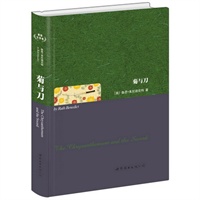|
本书详细内容 |
|
 |
| 书名 |
菊与刀(英文全本) |
| 作者 |
[美]鲁思·本尼迪克特 著 |
| 出版日期 |
2014-09-01 |
| 出版社 |
世界图书 |
ISBN号
(13位) |
9787510082450 |
ISBN号
(10位) |
7510082455 |
| 开本 |
32 |
| 页数 |
288 |
| 装帧 |
精装 |
| 定价(C$) |
8.3 |
| 约合(US$) |
6.56 |
|
|
 |
| [ 内容简介 ]
世界文学名著表现了作者描述的特定时代的文化。阅读这些名著可以领略著者流畅的文笔、逼真的描述、详细的刻画,让读者如同置身当时的历史文化之中。为此,我们将这套精心编辑的“名著典藏”奉献给广大读者。
我们找来了专门研究西方历史、西方文化的专家学者,请教了专业的翻译人员,精心挑选了这些可以代表西方文学的著作,并听取了一些国外专门研究文学的朋友的建议,不删节、不做任何人为改动,严格按照原著的风格,提供原汁原味的西方名著,让读者能享受纯正的英文名著。
随着阅读的展开,你会发现自己的英语水平无形中有了大幅提高,并且对西方历史文化的了解也日益深入广阔。
送您一套经典,让您受益永远!
本书为香港大学推荐书目之一,更多香港大学推荐,请点击进入。
内容推荐
《菊与刀》是鲁思·本尼迪克特最有名的作品,这本书是第二次世界大战接近尾声时,作者受美国政府委托,为解决盟军是否应该占领日本以及美国应该如何管理日本的问题,根据文化类型理论、运用文化人类学方法对即将战败的日本进行研究所得出的综合报告。
恬淡静美的“菊”是日本皇室家徽,凶狠决绝的“刀”是武士道文化的象征。鲁思·本尼迪克特运用文化人类学的方法,用“菊”与“刀”来揭示日本人的矛盾性格,即日本文化的双重性(如爱美而黩武、尚礼而好斗、喜新而顽固、服从而不驯等)。由此入手,进而分析日本社会的等级制及有关习俗,并指出日本幼儿教养和成人教养的不连续性是形成双重性格的重要因素。文本从日本人生活方式和典型事件入手,于生动的叙述中进行有力论析,语言富有智慧和幽默感。读之既启人深思,又引人入胜,是了解日本民族绕不过的经典读本。
作者简介
鲁思·本尼迪克特(1887—1948)美国著名文化人类学家、民族学家、诗人,代表作品有《文化模式》和《菊与刀》。她是20世纪初少有的女性学者,她和爱德华?萨丕尔提出最早的文化形貌论,认为文化如同个人,具有不同的类型与特征。她作品中提出的问题与关怀,至今仍受到人类学、历史学等学科的重视与关注。
目录
1. ASSIGNMENT: JAPAN
2. THE JAPANESE IN THE WAR
3. TAKING ONE’S PROPER STATION
4. THE MEIJI REFORM
5. DEBTOR TO THE AGES AND THE WORLD
6. REPAYING ONE-TEN-THOUSANDTH
7. THE REPAYMENT ‘HARDEST TO BEAR’
8. CLEARING ONE’S NAME 128
9. THE CIRCLE OF HUMAN FEELINGS
10. THE DILEMMA OF VIRTUE
11. SELF-DISCIPLINE
12. THE CHILD LEARNS
13. THE JAPANESE SINCE VJ-DAY
GLOSSARY
在线试读部分章节
Some of these parallels are in Malaysia, some in New Guinea, some in Polynesia. It is interesting, of course, to speculate on whether these show some ancient migrations or contacts, but this problem of possible historical relationship was not the reason why knowledge of these cultural similarities was valuable to me. It was rather that I knew in these simpler cultures how these institutions worked and could get clues to Japanese life from the likeness or the difference I found. I knew, too, something about Siam and Burma and China on the mainland of Asia, and I could therefore compare Japan with other nations which are a part of its great cultural heritage. Anthropologists had shown over and over in their studies of primitive people how valuable such cultural comparisons can be. A tribe may share ninety per cent of its formal observances with its neighbors and yet it may have revamped them to fit a way of life and a set of values which it does not share with any surrounding peoples. In the process it may have had to reject some fundamental arrangements which, however small in proportion to the whole, turn its future course of development in a unique direction. Nothing is more helpful to an anthropologist than to study contrasts he finds between peoples who on the whole share many traits.
Anthropologists also have had to accustom themselves to maximum differences between their own culture and another and their techniques have to be sharpened for this particular problem. They know from experience that there are great differences in the situations which men in different cultures have to meet and in the way in which different tribes and nations define the meanings of these situations. In some Arctic village or tropical desert they were faced with tribal arrangements of kinship responsibility or financial exchange which in their moments of most unleashed imagination they could not have invented. They have had to investigate, not only the details of kinship or exchange, but what the consequences of these arrangements were in the tribe’s behavior and how each generation was conditioned from childhood to carry on as their ancestors had done before them.
This professional concern with differences and their conditioning and their consequences could well be used in the study of Japan. No one is unaware of the deep-rooted cultural differences between the United States and Japan. We have even a folklore about the Japanese which says that whatever we do they do the opposite. Such a conviction of difference is dangerous only if a student rests content with saying simply that these differences are so fantastic that it is impossible to understand such people. The anthropologist has good proof in his experience that even bizarre behavior does not prevent one’s understanding it. More than any other social scientist he has professionally used differences as an asset rather than a liability. There is nothing that has made him pay such sharp attention to institutions and peoples as the fact that they were phenomenally strange. There was nothing he could take for granted in his tribe’s way of living and it made him look not just at a few selected facts, but at everything. In studies of Western nations one who is untrained in studies of comparative cultures overlooks whole areas of behavior. He takes so much for granted that he does not explore the range of trivial habits in daily living and all those accepted verdicts on homely matters, which, thrown large on the national screen, have more to do with that nation’s future than treaties signed by diplomats. |
 |

